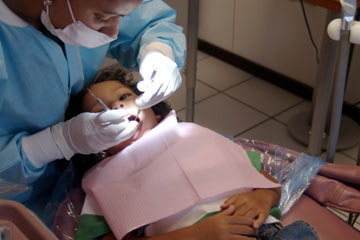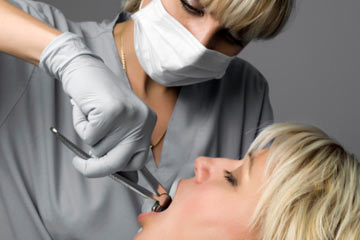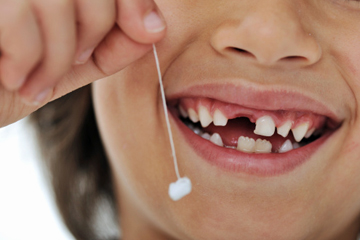
Some babies leave the womb and enter the world with teeth already in place. In about 1 in every 2,000 to 3,000 births, these natal teeth, or fetal teeth, make an appearance [source: MedlinePlus]. They’re often removed to spare a nursing mother from discomfort and to prevent the baby choking on them should they fall out.
But that isn’t the usual progression, of course. Primary teeth, the dentist’s name for baby teeth, begin to erupt as early as 3 months along. It’s usually the bottom two teeth that crop up first, no surprise to any of us who have seen Facebook photos of babies with gummy smiles.
Teething can be rough for both infant and parent. While some families get away with little to no squalling during the teething period, others have a considerably bumpier ride, which is why so many home remedies exist for teething pain, from a cold spoon to chew on, to a chilled washcloth. (Steer away from whiskey on the gums, folks. That’s why they make numbing gels for babies nowadays.)
Many people seem to think that dental care before the eruption of permanent teeth is a piece of sugar-free cake. That’s not the case. As soon as those little chompers appear, they should be cleaned with a baby toothbrush and water. The first visit to the dentist should occur by the first birthday, at the latest, and brushing with toothpaste starts around age 2.
Plaque, that lovely bacterial film that develops on our teeth, comes from the sugar and starches in foods. Sugary substances like sodas and candy contain them, of course, but many people don’t realize that nutritious foods, such as milk and fruit, have naturally occurring sugars in them as well. That means that even a baby who is exclusively breast- or bottle-fed is at risk for cavities, or caries. Acids in plaque attack the tooth’s enamel, burning holes in it that make perfect homes for bacteria. When left untreated, those holes simply grow larger until the whole tooth rots.
Baby bottle tooth decay came into the public consciousness in the 1970s, when the media began reporting on research that babies who slept with milk bottles got more cavities than babies who didn’t. Since then, the term has been revised to early childhood caries, or ECC. And ECC is an infectious disease.
Contents
- The Dangers of Untreated Cavities in Baby Teeth
- Treating Cavities in Baby Teeth
The Dangers of Untreated Cavities in Baby Teeth
How can cavities be contagious? Remember that bacteria are behind tooth decay, and bacteria can be transmitted from one person to another — for example, by saliva. If a baby’s caregiver (usually the mother) cleans the baby’s pacifier by putting it in her own mouth, or shares a spoon, she can transfer bacteria to the baby. The mutans streptococci are the most common germy culprits, although a new pathogen, Scardovia wiggsiae, was identified in February 2011 [source: ScienceDaily]. Prevention of ECC, then, starts with the parent. Treating a mother’s caries helps avoid them in a child.
The next step to prevention is being careful of what foods and liquids go into a kid’s mouth. Dipping a pacifier in honey or sugar is a bad idea, as is letting a kid sleep with a bottle, drink tons of fruit juice or soda, or breast-feed at will during the night. The American Dental Association recommends that children start drinking from a cup by the time they’re 1 [source: ADA]. The organization also discourages use of a sippy cup for an extended period of time.
According to the National Institute of Dental and Craniofacial Research, cavities in baby teeth are more prevalent and more severe in black, Hispanic and poor populations [source: NIDCR]. Those populations are also more likely to be untreated.
Pedodontist James Hicks Jr. of Roswell, Ga., says that the dangers of untreated caries are serious. At the very least, not filling a tooth can lead to dental sensitivity, dental pain and an abscess that causes facial swelling, all factors that can affect a child’s eating and speaking. At worst, infection can spread to the brain. A 12-year-old named Deamonte Driver died in February 2007 from an untreated tooth infection [source: Otto].
Even if a child simply loses the decayed tooth, it could affect how the permanent teeth grow in; if the space from the baby tooth isn’t preserved, the permanent teeth will crowd each other. (That’s why gaps between baby teeth are great, says Hicks — kids with no spaces in their smile are more likely to need braces later on.)
Eye of Newt, Toe of Frog, Tooth of Baby?
Long before the Tooth Fairy’s reign, the disposal of baby teeth was (and is) still a big deal. In some cultures, the teeth are buried; in others, they’re burned. One folk ritual involves feeding the primary tooth to an animal. Medieval Europeans, fearing the power of witches, regarded the ritual as a safeguard more than a rite of passage.
Treating Cavities in Baby Teeth
The costs of filling a tooth can vary. According to Hicks, it depends on how much of the tooth’s surface needs to be restored, what material is used and the method employed to treat the child. The smaller the cavity, the cheaper. Fillings can be made of silver alloy, gold, porcelain or composite resin [source: WebMD].
Sedation isn’t always necessary. A trick of the pedodontist trade is "tell, show and do." Explain to the child what’s going to happen and why, demonstrate it and then perform it. That’s enough to relieve anxiety for some kids and let the dentist do his or her job.
Nitrous oxide, or "laughing gas," is an option to help a child relax, and it’s a safe one. The child is still awake during the procedure and the gas wears off quickly, but some kids get freaked out by the mask.
Those who are more anxious might require oral sedation, which will make the child sleepy. "The physical risks of an oral sedation are minimal when the proper precautions have been taken and the patient is monitored throughout the procedure," says Hicks.
General anesthesia is the final option, because it does carry risks. A child with a disability, a severe anxiety or the need for extensive, lengthy dental work might be a candidate for this type of sedation, but it should be discussed thoroughly with the dentist.
Pediatric dentists have 2 to 3 years of additional training after dental school specifically in subjects like sedation and how to deal with children with special needs, so if your insurance covers a pediatric dentist, it’s a good option.
Hicks recommends finding a dentist that both you and your child trust. He advises, "Make sure you leave the appointment having learned something new about your child’s oral health."
Want more information? Visit the links and resources on the next page.
Whiter Than White
Permanent teeth are naturally more yellow than baby teeth.





